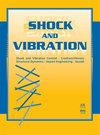Analysis of Wheel Wear and Wheel-Rail Dynamic Characteristics of High-Speed Trains under Braking Conditions
IF 1.2
4区 工程技术
Q3 ACOUSTICS
引用次数: 0
Abstract
When high-speed trains operate under braking conditions, the wheel-rail interaction increases significantly, which can lead to more serious wear problems. To analyze the evolution of wheel wear and the dynamic characteristics of wheel-rail under braking conditions, this paper first carries out long-term monitoring of the service state of wheel-rail during the operation period. The study analyzed the matching characteristics of the measured wheel-rail profile and calibrated the wear model by using the collected data. The resulting wear prediction model was then used to examine the wheel wear characteristics under braking conditions. The research results indicate that during the operation period, the wheel experiences tread concave wear within a range of ±20 mm of the rolling circle, at a rate of approximately 0.05 mm per 10,000 km. Meanwhile, the rail experiences top surface wear at a natural rate of about 0.09 mm per year. Concave wear causes the contact point of the wheel-rail to appear in two zones, resulting in a sudden change of contact geometric parameters. The concave worn wheel and rail with a 60 N profile have better matching compared to the 60 rail profile. Increasing the braking torque and wheel-rail friction coefficient will significantly increase the wheel wear depth on straight sections. On small-radius curve sections, rail side lubrication can significantly reduce high rail side wheel flange wear. A worn concave wheel can lead to unfavorable wheel-rail contact geometry characteristics and increase low-frequency components in the vehicle’s lateral dynamic response.制动条件下高速列车的车轮磨损和轮轨动态特性分析
当高速列车在制动条件下运行时,轮轨相互作用会显著增加,从而导致更严重的磨损问题。为了分析制动工况下车轮磨损的演变过程和轮轨的动态特性,本文首先对运行期间轮轨的服役状态进行了长期监测。研究分析了测量到的轮轨轮廓的匹配特性,并利用收集到的数据校准了磨损模型。然后,利用得到的磨损预测模型来研究制动条件下的车轮磨损特征。研究结果表明,在运行期间,车轮在滚动圆的±20 毫米范围内出现胎面凹面磨损,磨损率约为每 10,000 公里 0.05 毫米。同时,钢轨顶面的自然磨损率约为每年 0.09 毫米。凹面磨损会使轮轨接触点出现两个区域,导致接触几何参数发生突变。与 60 N 的轮轨轮廓相比,凹面磨损的轮轨与 60 N 的轮轨轮廓具有更好的匹配性。增加制动扭矩和轮轨摩擦系数会显著增加直线路段的车轮磨损深度。在小半径曲线路段上,轨道侧润滑可显著减少高轨道侧轮缘磨损。磨损的凹形车轮会导致不利的轮轨接触几何特性,并增加车辆横向动态响应中的低频成分。
本文章由计算机程序翻译,如有差异,请以英文原文为准。
求助全文
约1分钟内获得全文
求助全文
来源期刊

Shock and Vibration
物理-工程:机械
CiteScore
3.40
自引率
6.20%
发文量
384
审稿时长
3 months
期刊介绍:
Shock and Vibration publishes papers on all aspects of shock and vibration, especially in relation to civil, mechanical and aerospace engineering applications, as well as transport, materials and geoscience. Papers may be theoretical or experimental, and either fundamental or highly applied.
 求助内容:
求助内容: 应助结果提醒方式:
应助结果提醒方式:


